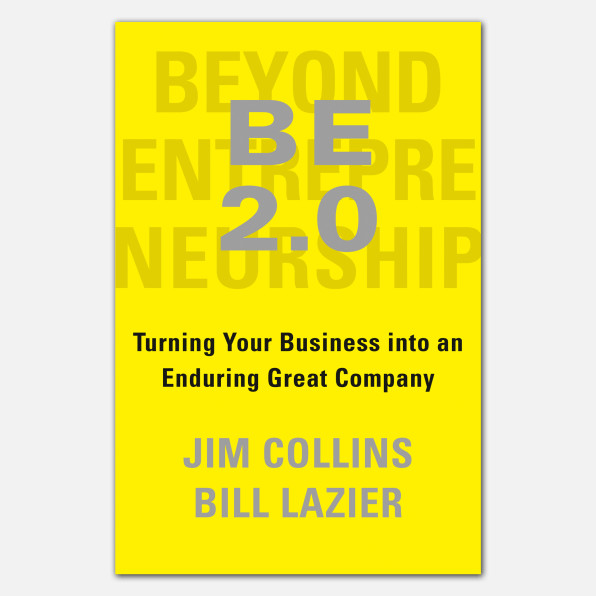Before Jim Collins wrote Built to Last and Good to Great he published Beyond Entrepreneurship. Originally published in 1992, Beyond Entrepreneurship grew out of a course Collins and Bill Lazier taught at the Stanford Graduate School of Business, and it has become a quiet favorite of entrepreneurs such as Netflix founder Reed Hastings. Last month Collins published Beyond Entrepreneurship 2.0, which he calls an “upgrade” of the original book, with new chapters and essays. It also includes what he describes as “the map,” or a framework that distills 30 years of research into a guide that entrepreneurs and companies can follow if they aspire to build enduring companies. In an interview with Fast Company editor-in-chief Stephanie Mehta, Collins notes that he and co-author Lazier highlighted many of the themes business leaders are touting today, such as purpose and stakeholder capitalism, while cautioning against a “built to flip” mentality. He also describes B.E. 2.0 as an “act of love” and a way to honor Lazier, who died in 2004. The conversation has been edited for length and clarity:
Fast Company: Why update Beyond Entrepreneurship, and why now?
Jim Collins: Beyond Entrepreneurship grew out of the course that Bill Lazier and I taught at Stanford’s business school. It was a course called “B352, Entrepreneurship and Small Business.” And for whatever reason, to this day, I’m not really sure why, I decided to recast the syllabus of the course for my section of it. This was not going to be a course on the mechanics and challenges of a being small business manager, it was: How to take an entrepreneurial venture and turn it into an enduring great company.
I think I got infected by…this idea that if you’re going to go to do something entrepreneurial, then you should set out to try to create something truly worthy of lasting, that can endure. There are people who have built these companies that are worthy of admiration that have had an impact on the world. That’s the standard that you should aspire. So that’s why the book is called Beyond Entrepreneurship. The key is the word “beyond,” and the subtitle is about turning your business into an enduring great company.
At the very time that we were working on Beyond Entrepreneurship, Jerry Porris and I had begun our research on visionary companies, looking in a very rigorous, data-based way, at the long course of history of companies that had attained this visionary status. We found that the companies that were the visionary over time, the enduring great companies, were guided by a purpose beyond profits. The economics were simply fuel to do something really purposeful. And those two [projects]coincided, and ended up in the Vision [chapter]in Beyond Entrepreneurship.
Fast forward a few years and Beyond Entrepreneurship kind of got lost a little bit because Built to Last became so big and then Good to Great became so big. But this book that Bill and I did together had a very loyal and small following. I don’t tend to ask for very many endorsements, but Reed Hastings endorsed this one. He said Beyond Entrepreneurship shaped his leadership style more than any book or any person. And it’s because it gave him the confidence to trust his inner core as to what was trying to do.
Bill Lazier died in 2004, and I really wanted to write something about Bill, to extend his legacy, to share his great wisdom with the world, to inspire a whole other generation of entrepreneurs. My wife, Joanne said, why don’t you re-release and upgrade Beyond Entrepreneurship? Give it the life it deserves. Bring people back to that spirit.
FC: What are some of the upgrades?
JC: After 30 years of research, I had a single map. If an entrepreneur said to me, “I want to build an enduring great company,” I would say, “read BE 2.0 and follow the map.” I want to gift the map to the entrepreneurial generation to come.
I believe that business done right, meaning in the most aspirational way, is one of the most meaningful and noble things you could do with a life. You think about what Walt Disney’s life added up to. Or William McKnight, inventing the idea that you could make innovation a systematic replicable process, which is what he did at 3M. Or you think about [Patagonia founder] Yvon Chouinard saying, “I’m going to think of accompany as a role model and a tool for change in the world. And I’m going to prove it with our success and the quality of what we do.” It’s not about flipping and cashing out, this is a choice. And then you could get to the end of your life and say, “Wow, what a life well spent.”
FC: Speaking of flipping, you wrote one of Fast Company‘s most iconic articles, Built to Flip, which ran in 2000. It was meant as a warning, but there’s a short-termism that still pervades entrepreneurship today.
JC: On the front page of the paper there’s [Doordash’s] $71 billion IPO. I’m not saying that’s good or bad. I’m not saying it’s the right or wrong number. I’m simply saying that it sort of sends a signal that the definition of success is, “wow, you took your company public for this amount of money.” And of course, in an era of tremendous liquidity and zero interest rates, it’s just the fuel, right? You’d almost feel dumb not to take advantage of it, right? And, and of course, if you I’m stocking up fuel to build, [your]version of the next Google or the next Amazon or Netflix, then it could be just like, ‘Hey, this is a chance for me to put a a lot of oxygen canisters for the climb on the mountain.”
But if it’s like, “No, this is just a great time to, get rich, and three years later we don’t really care what’s happening to the company,” if that’s what’s happening, then we’re back to “built to flip” world. One of my great mentors, Michael Ray, who had a big impact on me at Stanford, had a wonderful line, which is, “Comparison is the primary sin of modern life.”
And when you get into an era where you have competing IPOs, competing valuations, competing cash-out moments, competing houses in Silicon Valley…the comparison gene starts to take over, and your measurement starts to become defined by these visible events. And maybe building a company that is going to do really great over time isn’t so visible. Especially if you decide to keep it for yourself, you might choose to remain private and take a longer time to do it. Chouinard is a great example of that. And so when you get into the comparison as the primary sin of modern life, and then you get into a frothy period like this, the comparison starts to run rampant and people start [thinking], “Well, gosh, this is what people are doing. Maybe this is what I should be doing. Maybe this is what the real definition of success is.” But as Bill [Lazier] always pointed out to me, if you measure your success by money, you always lose.
FC: Since you wrote, Built to Last, several huge companies have been founded: Facebook, which was founded in 2004, Google in 1998, Amazon in 1994. Do you feel like these companies embody the tenets that you laid out in the book?
JC: Some of them are, in a modern way, picking up, [on]Beyond Entrepreneurship and Built to Last. I think that Reed [Hastings] at Netflix is a good example of that. One may or may not agree with what his values are, or Google’s values or Amazon’s, but they were really clearly setting out to try to build something enduring and impactful in their way.
Amazon really grabbed the flywheel idea from Good to Great, which is in the map [in Beyond Entrepreneurship 2.0].
FC: How does the flywheel contribute to longevity?
JC: Imagine you would have said the finish line of Amazon was 1999. The “built to flip” view is, let’s build it up to a hundred turns [of the flywheel]and flip it. The “built to last” view is a hundred turns is just the first hundred terms on the flywheel. Then it’s a thousand to a million turns on the flywheel. Then it’s a million to a billion turns on the flywheel and the great results happen down the road, right? Look at Disney today. That flywheel started in 1927. If it would have stopped the flywheel after three films, there’s no Disneyland, there’s no streaming services. There’s no, you know, harnessing Pixar. I think that folks like [Amazon founder Jeff] Bezos and the folks at Google, Reed Hastings at Netflix, they understand this long-term flywheel effect.
FC: If the core message of Beyond Entrepreneurship hasn’t changed in 30 years, has the storytelling needed to change to get the message across to a new generation of entrepreneurs?
JC: Yes and no. The vision framework or the concepts that are in the map were research-driven. It was a very rigorous process. We know what correlates with having a much greater chance of building an enduring great company. Then you put those into concepts that people can really absorb, whether its Level Five Leadership, or BHAG (Big Hairy Audacious Goals) Then there’s this step that’s really critical, which is picking precisely the right story to teach the idea.
The purpose of the story is not the story is not the idea. The story is the, is the, is the human vessel for teaching an idea. There are maybe 30 different stories you could pick to help somebody really grasp an idea, but picking the right one for the right audience at the right time, that I think is the art. Take The Illiad, which I’ve read multiple times. It is a story about honor. But maybe if you want to communicate the same idea, you instead teach about Katharine Graham taking over The Washington Post and facing this really difficult choice after her husband had committed suicide. She has to step outside the walls and, and, and fight for what is dear, which is the soul of The Post and its role in the world. And, and that’s a human story, right? But it ties into something deep and timeless.

This article first appeared in www.fastcompany.com
Seeking to build and grow your brand using the force of consumer insight, strategic foresight, creative disruption and technology prowess? Talk to us at +971 50 6254340 or mail: engage@groupisd.com or visit www.groupisd.com/story


